Ensure Network Uptime with DNS Monitoring
Have you ever wondered how the internet manages to translate the domain names you type into the browser into IP addresses that connect you to your desired websites?
The answer lies in the Domain Name System (DNS), a complex network of servers and protocols that makes online communication possible. But with this complexity comes the need for DNS monitoring, which plays a crucial role in ensuring website availability, preventing security breaches, and optimizing network performance.
Imagine typing in a website address into your browser, but instead of accessing the site, you're redirected to a fake page created by cybercriminals to steal your personal information. This is just one of the many ways in which a DNS attack can compromise your online security.
To protect against such threats, DNS monitoring is crucial, allowing businesses to identify and prevent attacks. In this blog, we will explore DNS monitoring in-depth and the related topics in detail.
Let us dive in and explore!
Table of contents
- What is DNS?
- DNS Server Types
- DNS Security Challenges
- What is DNS Monitoring?
- How does DNS Monitoring Works?
- DNS Monitoring Metrics
- DNS Monitoring Tools
- How to monitor DNS using Atatus?
What is DNS?
DNS stands for Domain Name System. It is a system that translates human-readable domain names (such as Facebook.com) into IP addresses (such as 185.60.216.35) that computers can understand and use to connect to websites, servers, and other internet-connected devices.
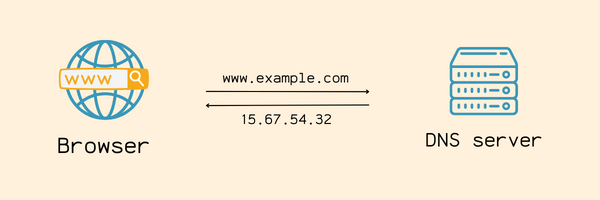
Every device connected to the internet has an IP address, which is a numerical identifier that uniquely identifies that device on the network. However, IP addresses can be difficult for humans to remember and use. This is where DNS comes in – it provides a way to associate domain names with IP addresses, making it easier for users to access websites, send emails, and use other internet services.
DNS works by maintaining a distributed database of domain names and their corresponding IP addresses. When a user types a domain name into their web browser, the browser sends a DNS query to a DNS resolver, which is typically provided by the user's Internet Service Provider (ISP). The resolver then queries the DNS servers responsible for the domain in question to find the corresponding IP address, and returns the IP address to the browser, which can then establish a connection with the web server hosting the website.
DNS is a critical component of the internet infrastructure, and it enables us to browse the web, send emails, stream videos, and access many other online services. Without DNS, we would have to memorize the IP addresses of all the websites we want to visit, which would be difficult and impractical.
DNS Server Types
DNS servers maintain a distributed database of domain name records and respond to DNS queries from clients. DNS servers can be categorized into several types, including DNS recursor servers, root nameservers, TLD nameservers, and authoritative nameservers.
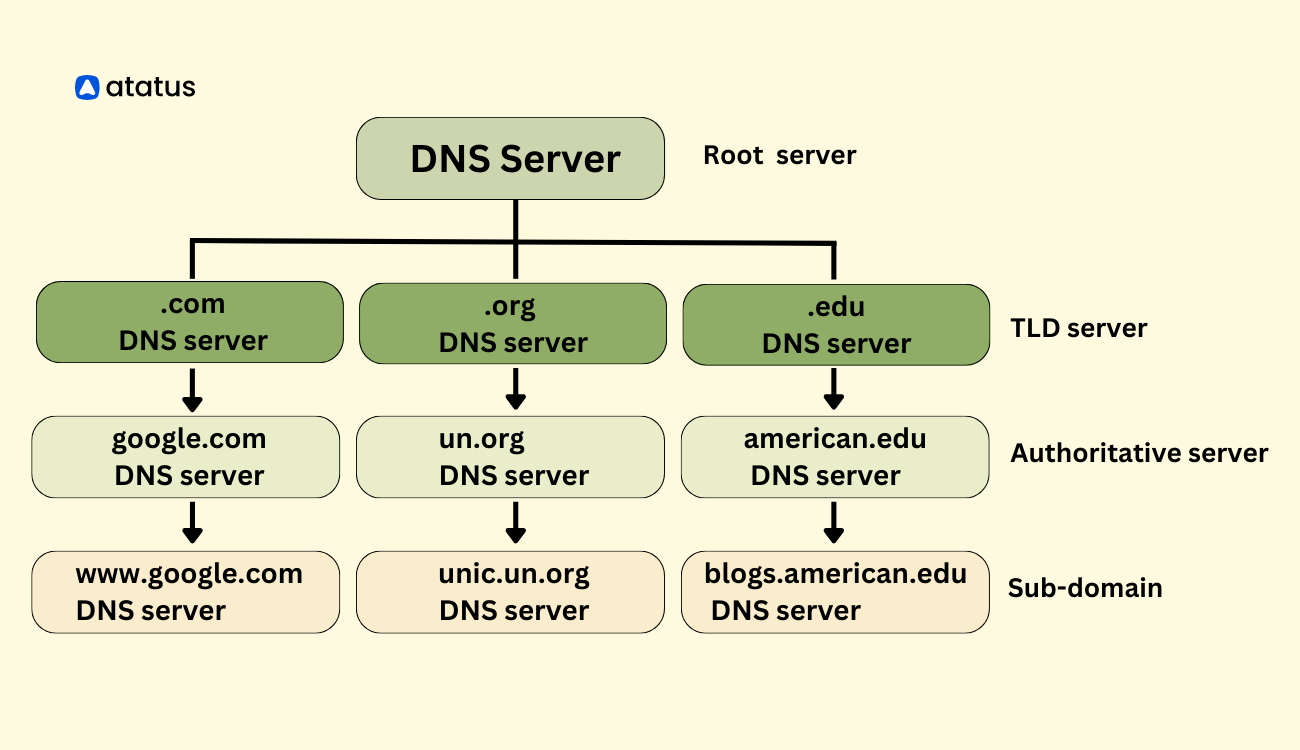
1. DNS Recursor
DNS recursors are typically operated by Internet Service Providers (ISPs) or other organizations that provide internet access to end-users. A DNS recursor is like a detective for the internet. It receives a DNS query from the computer, looks for the IP address by asking other DNS servers, and then gives the answer back to the computer.
2. Root Nameserver
The root nameservers are a critical component of the Domain Name System (DNS) that help facilitate the resolution of domain names to IP addresses. There are 13 root nameservers located around the world, each with its own IP address.
When a DNS query is initiated for a domain name, the DNS resolver first contacts one of the root nameservers to obtain the IP address of the authoritative nameserver for the top-level domain (TLD) of the domain name being queried.
The root nameservers do not maintain information about specific domain names or IP addresses. Instead, they serve as the first point of contact in the DNS resolution process and direct DNS resolvers to the appropriate TLD nameserver.
3. TLD Nameserver
The Top-Level Domain (TLD) nameservers are responsible for storing and managing the DNS records for specific top-level domains, such as .com, .org, .net, etc.
TLD nameservers are responsible for managing the DNS records for specific top-level domains and directing DNS resolvers to the authoritative nameservers for specific domains. They play a critical role in the DNS resolution process and are a key component of the internet's functionality.
4. Authoritative Nameserver
An authoritative nameserver, is responsible for storing and managing the DNS records for a specific domain. It is the final authority for resolving DNS queries for that domain.
When a DNS resolver receives a query for a domain name, it contacts the root nameservers to obtain the IP address of the TLD nameserver associated with the TLD of the domain name being queried.
The TLD nameserver then responds to the query by providing the IP address of the authoritative nameserver for the domain being queried.
DNS Security Challenges
As previously discussed, we know that DNS is a critical component of the internet infrastructure. Despite its importance, DNS is vulnerable to a range of cyber threats. These attacks can have severe consequences, including data theft, downtime, and reputational damage.
And this is where, DNS monitoring plays a vital role. Here are some of the security challenges faced by DNS:
- DNS cache poisoning: DNS cache poisoning occurs when an attacker injects false information into a DNS cache, redirecting users to fraudulent or malicious websites. This can result in the theft of sensitive information or the delivery of malware. DNS monitoring can help detect and prevent these attacks.
- DNS hijacking: DNS hijacking involves changing the authoritative DNS server for a domain name to one controlled by the attacker. This enables the attacker to intercept traffic and steal sensitive information. DNS monitoring can help detect these unauthorized changes to the authoritative DNS server.
- DNS DDoS attacks: In DNS amplification attacks, attackers use DNS servers to send large volumes of traffic to a target system, overwhelming it and causing it to become unavailable to legitimate users. DNS monitoring can help detect and prevent these large volumes of DNS requests.
What is DNS Monitoring?
DNS monitoring refers to the process of monitoring the Domain Name System (DNS) for various purposes such as ensuring its availability, detecting and mitigating potential security threats, and optimizing its performance.
To put it in simple terms, DNS monitoring is like keeping an eye on a translator who helps you talk to someone who speaks a different language. Also it detects and prevent cyber attacks on the DNS infrastructure, enabling quick remediation of DNS issues, and ensures high availability and reliability of DNS services.
The translator is the DNS server, and it helps your computer connect to websites by translating domain names (like google.com) into IP addresses (like 172.217.7.238). By monitoring DNS, you can ensure that your computer can find the websites you want to visit and stay safe online.
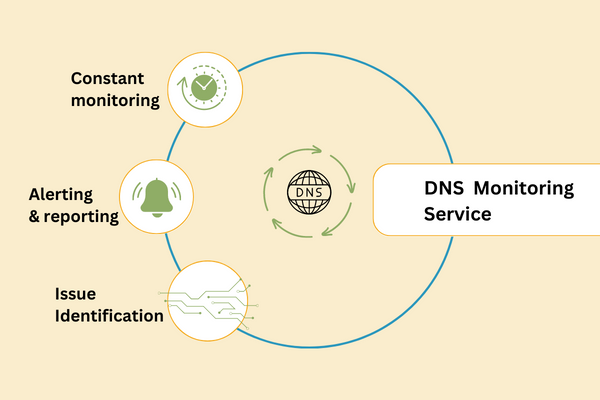
How does DNS Monitoring works?
DNS monitoring works by capturing and analyzing DNS traffic to identify patterns and anomalies that may indicate a problem. This typically involves collecting DNS data, including queries, responses, and other activities related to domain name resolution, in real-time. The collected DNS data is analysed for various metrics, such as query volume, response times, error rates, latency and DNS traffic patterns.
The DNS monitoring tool generates alerts based on the analysis of the DNS data. For example, an alert may be triggered if there is an increase in DNS query failures or if a specific DNS record is not responding. It visualizes the DNS data in the form of reports, graphs, and charts to provide insights into the performance, security, and availability of the DNS infrastructure.
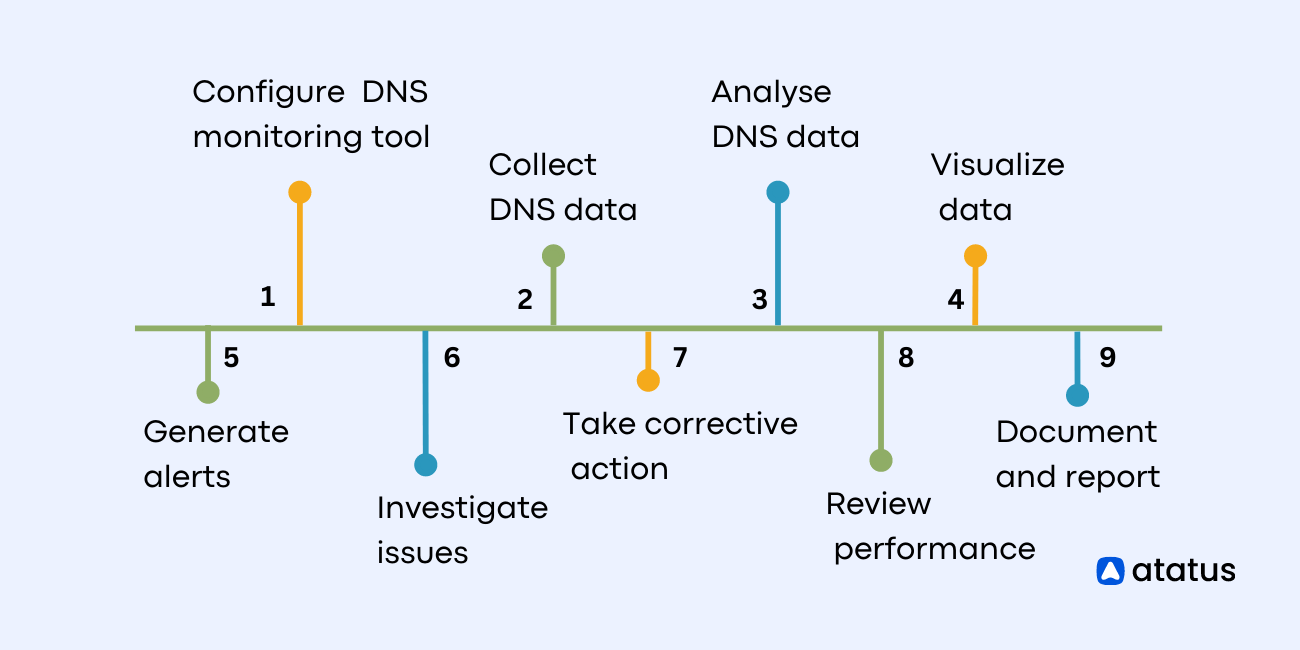
If an alert is triggered or if the DNS data analysis reveals any issues, the DNS monitoring team investigates the issue to identify the root cause. Based on the investigation, the DNS monitoring team takes corrective action to resolve the issue.
For example, they may modify DNS configurations, update DNS records, or add new DNS servers. The DNS monitoring team reviews the performance of the DNS infrastructure after taking corrective action to ensure that the issue is resolved and the DNS infrastructure is performing optimally.
The DNS monitoring team documents the issue, the investigation, and the corrective action taken. They also generate reports to provide insights into the DNS infrastructure's performance and to identify trends that may require further action.
DNS Monitoring Metrics
- DNS resolution time: This metric measures the time it takes for a DNS query to be resolved. By tracking this metric, you can identify how long it takes for your DNS server to return a response to a query. This can help you identify slow response times and take measures to optimize your DNS infrastructure.
- DNS lookup failures: This metric tracks the number of DNS queries that fail to resolve. You can quickly identify DNS-related issues that may be causing connectivity problems for your users. This can help you take quick action to fix the issues and minimize the impact on your users.
- DNS lookup success rate: This metric tracks the percentage of DNS queries resolved successfully. You can easily determine the health of your DNS infrastructure and ensure that your users can access your services without interruption.
- DNS query count: This metric tracks the total number of DNS queries made during a given time period. By monitoring this metric, you can determine the overall load on your DNS infrastructure and identify trends in DNS query usage.
- DNS response size: This metric measures the size of the response received from a DNS query. By tracking this metric, you can identify DNS-related issues that may be impacting the performance of your applications, such as oversized DNS responses that take longer to process.
- DNS server availability: This metric tracks the availability of the DNS server being monitored. Ensure that your DNS infrastructure is always available and quickly detect any issues that may arise.
- DNS server response time: This metric measures the time it takes for a DNS server to respond to a query. Identify slow or unresponsive DNS servers, allowing you to take proactive measures to ensure your users can access your services without interruption.
DNS Monitoring Tools
DNS monitoring tools helps to monitor DNS servers and related infrastructure to ensure their availability, performance, and security. These tools can help detect issues with DNS servers and resolve them quickly, reducing the impact on users and preventing potential downtime.
The tools typically provide a range of features, including monitoring of DNS server availability, response times, query volumes, and query types. Some tools can also monitor DNS zone transfers, DNS record lookups, and DNS service availability.
There are various DNS monitoring tools available, ranging from open-source solutions to enterprise-level tools with advanced features and scalability. The choice of tool will depend on specific needs and requirements, such as the size and complexity of the infrastructure being monitored, the level of customization required, and the budget available.
Here are some popular DNS monitoring tools:
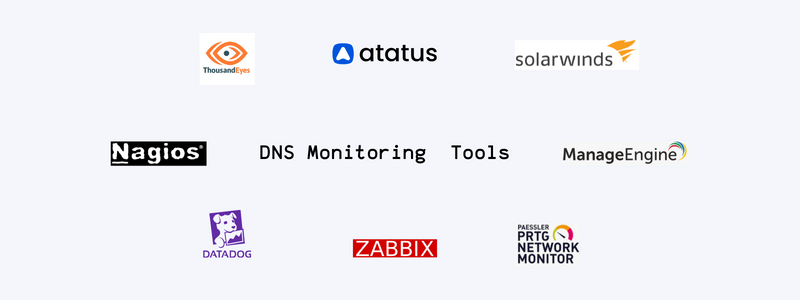
- Atatus: With Atatus DNS monitoring, you can track the performance and uptime of your DNS servers and ensure that they are operating as expected. You can also detect issues such as slow response times or DNS errors, which can impact the user experience on your website or application.
- SolarWinds: SolarWinds is a cloud-based DNS monitoring solution that offers real-time monitoring of DNS servers, DNS zones, and DNS queries. The tool provides DNS query logging, alerting, and performance metrics.
- Datadog: Datadog is a cloud-based monitoring tool that offers DNS monitoring capabilities which can monitor DNS response times, query logs, and server availability. The tool also provides real-time alerting and analytics.
- ManageEngine: ManageEngine is a network monitoring tool that offers comprehensive monitoring of DNS servers, zones, and records. The tool provides real-time monitoring, alerting, and reporting on DNS server performance and availability.
- Nagios: Nagios is a widely used open-source network monitoring tool that supports monitoring of DNS servers. Nagios can monitor DNS zone transfers, DNS record lookups, and DNS service availability.
- Zabbix: Zabbix is an open-source monitoring tool that can monitor DNS servers and provide real-time visibility into the DNS server status, performance, and availability. Zabbix can also monitor DNS queries and response times.
- PRTG Network Monitor: PRTG Network Monitor is a comprehensive network monitoring tool that can monitor DNS servers, including DNS query times, server response times, and record lookups. PRTG can also monitor DNS traffic and alert on DNS server failures.
- Thousand Eyes: With ThousandEyes, users can track DNS queries and responses, and monitor DNS servers and zones. The platform allows users to create custom DNS tests and alerts, set up synthetic DNS transactions to simulate user traffic, and analyze DNS traffic patterns to identify potential issues before they impact end-users.
How to monitor DNS using Atatus?
You can monitor DNS using Atatus monitoring tool by following these steps:
Step 1: Log in to your Atatus account and navigate to the "Synthetic" tab.
Step 2: Click on "New check" in the right corner of the dashboard and choose "New API/Web Check".
Step 3: Choose Request Type as DNS.
Step 4: Enter the Domain name. Enter the API Check name to identify the specific check you are performing, such as "DNS API Check". The default port number is set to 53, but it can also be changed. Optionally, add tags to the API check to group it with other related checks or to filter results based on specific criteria.

Step 5: Based on the request type you select, there will be some predefined assertions. Besides that, you can also create custom assertions by clicking on the "Add assertion button", which helps you to determine whether a check has been successful.

Step 6: You can either select all location or you can choose any particular location to check from the given location.
Step 7: Select the run type
- Parallel: Runs the check on all parallel locations.
- Sequential: Runs the check at each location specifically.

Step 8: Specify the test frequency on how often the test should be performed.

Step 9: Define the alert conditions based on the number of retries to be done when an failure occurs.
Step 10: Set up the notification channel and notify your team about the expiration of the DNS server
Step 11: Click on "Create New Check" and start monitoring DNS server.

Conclusion
As technology continues to advance, so do the threats facing organizations in the digital landscape. DNS monitoring is a critical tool that organizations can leverage to keep their networks safe and secure.
DNS monitoring is a critical aspect of network security that should not be ignored. By monitoring DNS traffic, organizations can detect and prevent potential cyber attacks, such as malware infection, before they can cause significant damage.
By prioritizing DNS monitoring, organizations can stay one step ahead of cyber threats and keep their data and systems secure.
Global DNS Monitoring with Atatus
Atatus offers DNS Synthetic Monitoring feature that helps users monitor the performance and availability of their DNS servers. It helps users ensure that your DNS servers are performing optimally, reducing the risk of website downtime and slow response times, and providing a reliable and fast experience for their users.
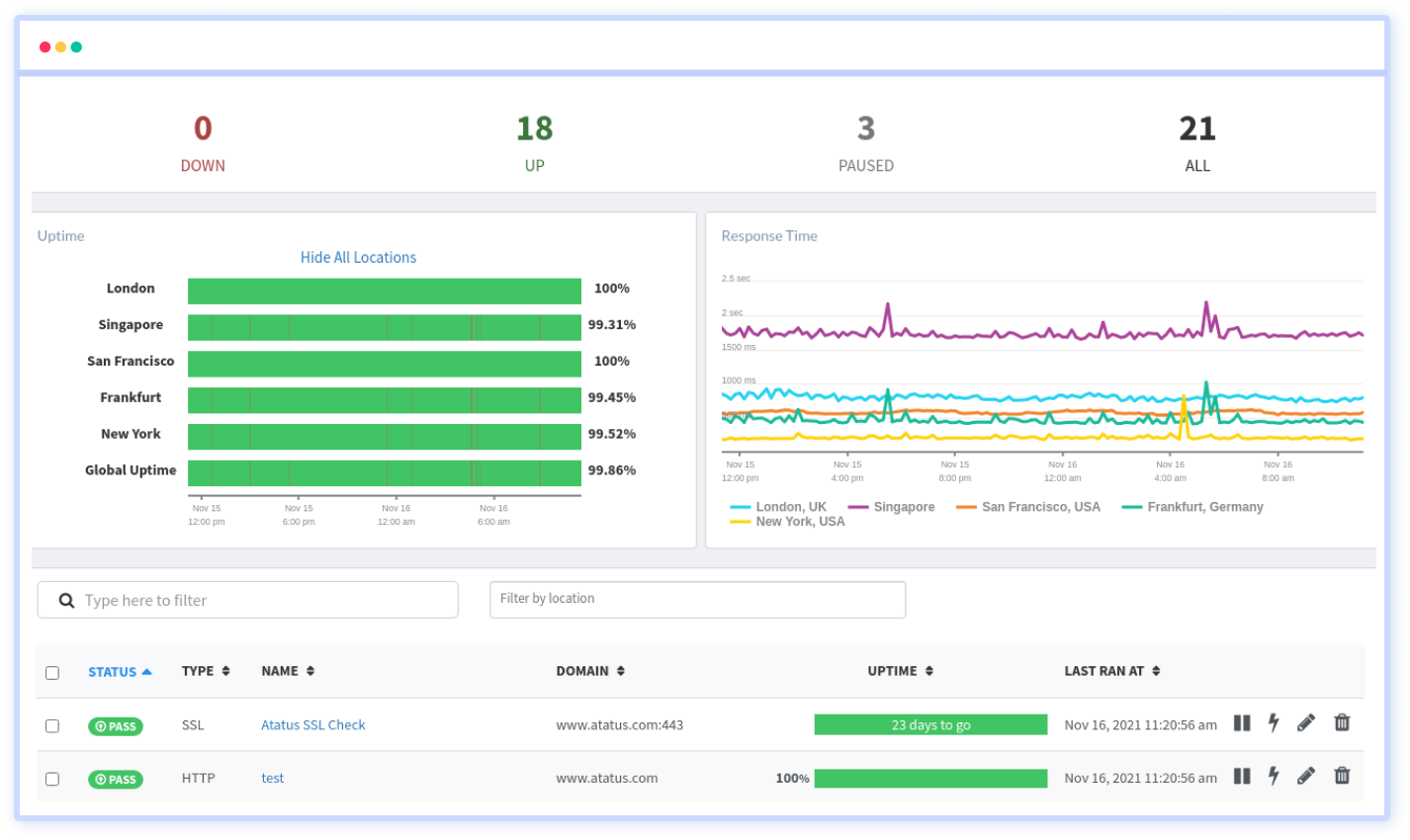
With Atatus DNS Monitoring, users can monitor their DNS servers from multiple locations worldwide to ensure that their domain names are resolving correctly and quickly. This feature allows users to:
- Monitor DNS uptime and response time: Atatus monitors the availability and performance of DNS servers and alerts users if there are any issues.
- Troubleshoot DNS issues: Atatus provides detailed information on DNS queries and responses, allowing users to quickly identify and fix any issues.
- Test DNS from multiple locations: Atatus tests DNS resolution from multiple locations worldwide, providing users with a global view of their DNS performance.
#1 Solution for Logs, Traces & Metrics
APM
Kubernetes
Logs
Synthetics
RUM
Serverless
Security
More

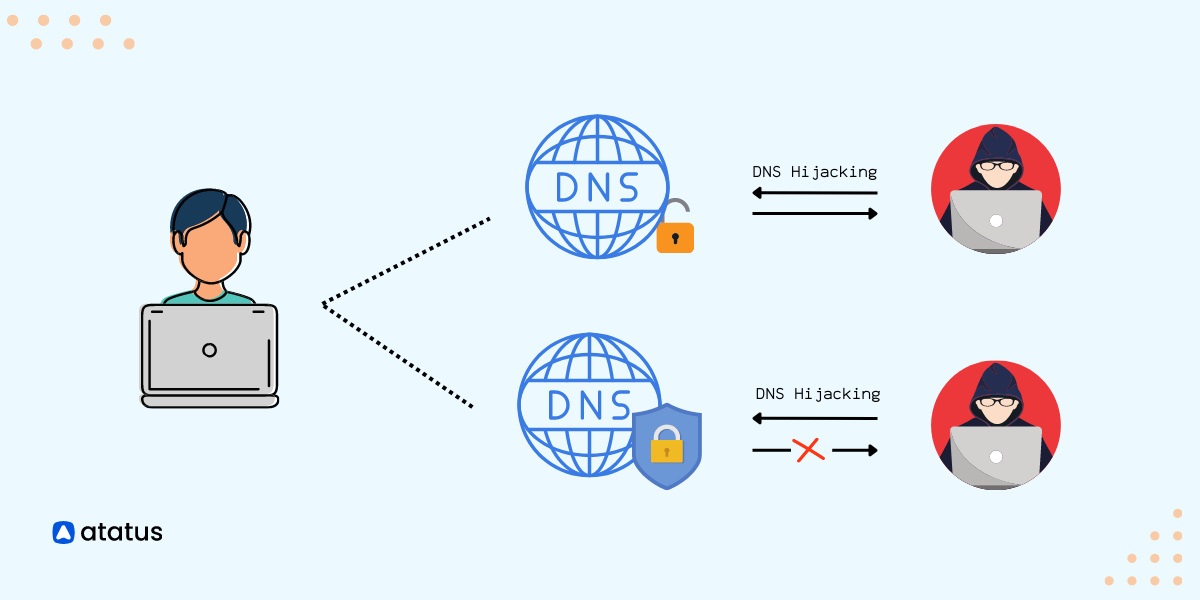



![Top DNS Monitoring Tools [2025 Guide]](/blog/content/images/size/w960/2023/05/dns-monitoring-tools-1-.png)